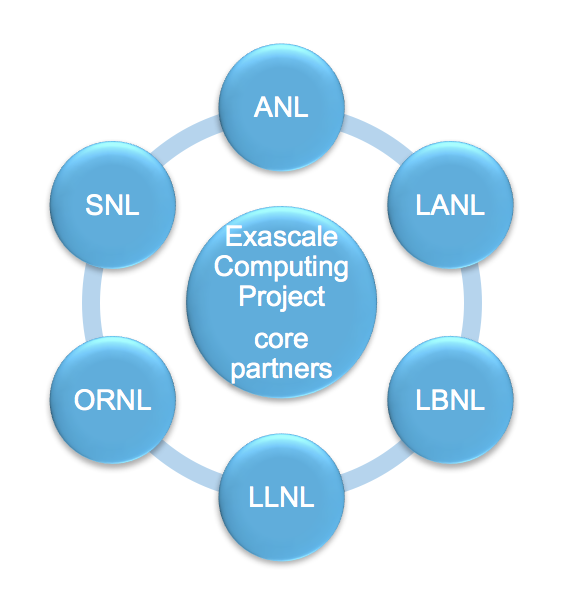The much-anticipated PathForward awards for hardware R&D in support of the Exascale Computing Project were announced today with six vendors selected – AMD, Cray, Hewlett Packard Enterprise (HPE), IBM, Intel, and NVIDIA. The Department of Energy (DoE) will provide $258 million while the vendors must contribute at least 40 percent of the total costs bringing the total investment to at least $430 million. Under the recently accelerated ECP timetable, the U.S. expects to field one or two exascale machines in 2021 followed by others in the 2023 timeframe.
Few details about the specific technology projects being undertaken by the PathForward companies were revealed, nor was how the money will be divided among the vendors. Nevertheless the awards mark an important milestone in ECP efforts noted ECP director Paul Messina.
 Speaking at a press pre-briefing yesterday, Messina said the PathForward investment was critical to moving hardware technology forward at an accelerated pace. “By that I mean beyond what the vendor or manufacture roadmaps currently have scheduled. [It also helps bridge] the gap between open ended architecture R&D and advanced product development as focused on the delivery of the first of a kind capable exascale systems,” said Messina.
Speaking at a press pre-briefing yesterday, Messina said the PathForward investment was critical to moving hardware technology forward at an accelerated pace. “By that I mean beyond what the vendor or manufacture roadmaps currently have scheduled. [It also helps bridge] the gap between open ended architecture R&D and advanced product development as focused on the delivery of the first of a kind capable exascale systems,” said Messina.
The ECP program has many elements. PathForward awards are intended to drive the hardware technology research and development required for exascale. Applications and software technology development fall under different ECP programs and have a different budget. The actual procurement of the eventual exascale systems is also done differently and funded separately; the individual national labs and facilities which will house and operate the computers purchase their individual systems directly. It now seems likely the first two exascale computing sites will be Argonne National Laboratory and Oak Ridge National Laboratory based on spikes in their facilities budget in the proposed FY 2018 DoE budget.
Much of today’s announcement and yesterday’s briefing had been expected. Messina did provide confirmation that Aurora, the planned successor to Mira supercomputer at Argonne National Laboratory, is likely to be pushed out or changed. “At present I believe that the Aurora system contract is being reviewed for potential changes that would result in a subsequent system in a time different timeframe from the original Aurora system. Since it’s just early negotiations I don’t think we can be any more specific that,” he said.
It would have been interesting to get a clearer sense of a few specific PathForward technology projects but none were discussed. Much of the work is predictably under NDA. Messina identified what are by now the familiar challenges facing the task of achieving exascale computing: massive parallelism, memory and storage, reliability, and energy consumption. “Specifically the work funded by PathForward has been strategically aligned to address those key challenges through development of innovative memory architectures, higher speed interconnect, improved reliability of systems, and approaches for increasing computer power and capability without prohibitive increases in energy demand,” he said.
Messina noted vendor progress in PathForward would be closely monitored: “Firms will be required to deliver final reports on the outcomes of their research but it’s very important to note this is a co-design effort with other [ECP] activities and we will be having frequent, formally scheduled intermediate reviews every few months. The funding for each of the vendors is based on specific work packages, and as each work package is delivered which would be an investigation on a particular aspect of the research. So it isn’t that we send the money and wait three years and get an answer.”
Messina also emphasized the labs (eventual systems owners) and the ECP app/software teams would be deeply involved in co-design and work product assessment. “Application developers and systems software developers, software library developers, for example, will participate in those evaluations,” he said.
 All of the vendors emphasized expectations to incorporate results of their exascale research into their commercial offerings. William Dally, chief scientist and SVP of research at NVIDIA noted this is NVIDIA’s the sixth DoE R&D contract and that previous research contracts led to major innovations, “such as energy efficient circuits and the NVLink interconnect being incorporated into our Maxwell, Pascal, and Volta GPUs.”
All of the vendors emphasized expectations to incorporate results of their exascale research into their commercial offerings. William Dally, chief scientist and SVP of research at NVIDIA noted this is NVIDIA’s the sixth DoE R&D contract and that previous research contracts led to major innovations, “such as energy efficient circuits and the NVLink interconnect being incorporated into our Maxwell, Pascal, and Volta GPUs.”
In the official DoE release, Secretary of Energy Rick Perry is quoted, “Continued U.S. leadership in high performance computing is essential to our security, prosperity, and economic competitiveness as a nation,” said Secretary Perry. “These awards will enable leading U.S. technology firms to marshal their formidable skills, expertise, and resources in the global race for the next stage in supercomputing—exascale-capable systems.”
It does seem as if increasing tension in the international community is firing up regional and national competitive zeal in pursuit of exascale. Here’s an excerpt from today’s official release:
“Exascale systems will be at least 50 times faster than the nation’s most powerful computers today, and global competition for this technological dominance is fierce. While the U.S. has five of the 10 fastest computers in the world, its most powerful — the Titan system at Oak Ridge National Laboratory — ranks third behind two systems in China. However, the U.S. retains global leadership in the actual application of high performance computing to national security, industry, and science.”
 Pressed on how the U.S. stacked up against internationals rivals, particularly China, in the race to exascale, Messina said, “Our current plan is to have delivery of at least one, not necessarily one, in 2021. I would not characterize that as to catch up with China. We do know of course that China has indicated they plan to have at least one exascale system in 2020 but we, for example, do not know whether that system will be a peak exaflops system versus what we are planning to deliver. A concise answer [to your question is we plan to deliver], at least one system in 2021 and another if not in 2021, then in 2022.”
Pressed on how the U.S. stacked up against internationals rivals, particularly China, in the race to exascale, Messina said, “Our current plan is to have delivery of at least one, not necessarily one, in 2021. I would not characterize that as to catch up with China. We do know of course that China has indicated they plan to have at least one exascale system in 2020 but we, for example, do not know whether that system will be a peak exaflops system versus what we are planning to deliver. A concise answer [to your question is we plan to deliver], at least one system in 2021 and another if not in 2021, then in 2022.”
See HPCwire article for a broader overview of the ECP, Messina Update: The US Path to Exascale in 16 slides.
The six selected PathForward vendors all seek to leverage their various expertise and ongoing R&D efforts. Senior executives and research staff from each company participated in yesterday’s briefing but very few specific details were offered, perhaps understandably so. Here are snippets from their comments.
- AMD. “Exascale is important because it pushes industry to innovate more and faster. While the focus of the PathForward program is on HPC the benefits are applicable across a wide range of computing platforms and cloud services as well as computational domains such as machine learning and data science,” said Alan Lee, corporate VP for research and advanced development. He positioned AMD as the only company with both x86 and GPU offerings and expertise in melding the two.
- Cray. “We care very little about peak performance. We are committed to delivering sustained performance on real workloads,” said Steve Scott, SVP and chief technology officer. Cray intends to explore new advances in node-level and system-level technologies and architectures for exascale systems. “[We’ll focus] on building systems that are highly flexible and upgradeable over time in order to take advantage of various [emerging] processor and storage technology.”
- HPE. HPE plans to leverage its several years of R&D into memory driven computing technologies – think The Machine project. “PathForward will significantly accelerate the pace of our development and allow us to leverage activities and investments such as The Machine. [W]e will accelerate R&D into areas such as silicon photonics, balanced systems architecture, and software [for example],” said Mike Vildibill, VP, advanced technologies, exascale development & federal R&D programs.
- IBM. “[We believe] future computing is going to be very data centric and we are focused very much on building solutions that allow complex analytics and modeling and simulation to actually be used on very large data sets. We see the major technical challenges to an exascale design to be power efficiency, reliability, scalability, and programmability and we feel very strongly those challenges need to be addressed in the context of a full system design effort,” said Jim Sexton, IBM Fellow and director of data centric systems, IBM Research.
- Intel. “Exascale from Intel’s perspective is not only about high performance computing. It’s also about artificial intelligence and data analytics. We think these three are all part of the solution and need to be encompassed. So HPC is continuing to grow. It’s really established itself as one of the three pillars of scientific discovery, along with theory and experiment. AI is quickly growing and probably the fastest growing segment of computing as we find ways to efficiently use data to find relationships to make accurate predictions,” said Al Gara, Intel Fellow, data center group chief architect, exascale systems. He singles out managing and reducing power consumption as one area Intel will work on.
- NIVDIA. “This contract will focus on critical areas including energy efficiency, GPU architectures and resilience, and our finding will certainly be incorporating to future generations of GPUs after the Volta generation,” said Dally, Ph.D. “It also allows us to focus on improving the resilience of our GPUs which allows them to be applied at greater scale than in the past.”
At least for the moment, the expectation is work done during this PathForward contract will be sufficient to support ECP. Messina said, “At present, we are not [planning a second PathForward RFP for the 2021 systems.]” in response to a question.
Link to DoE press release: https://exascaleproject.org/path-nations-first-exascale-supercomputers-pathforward/





























































